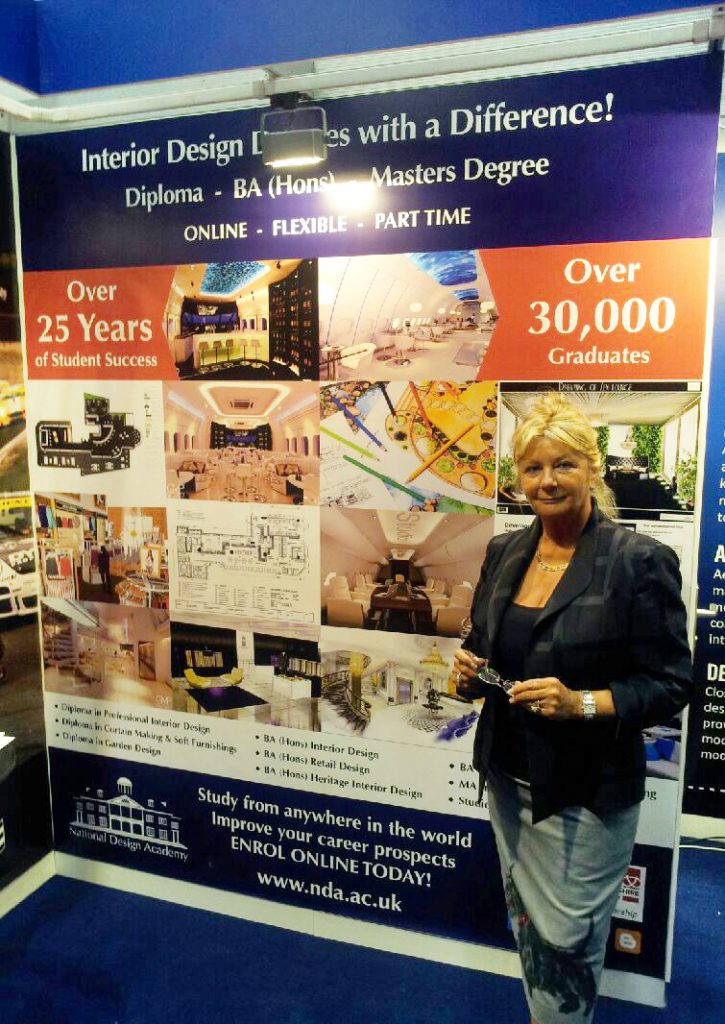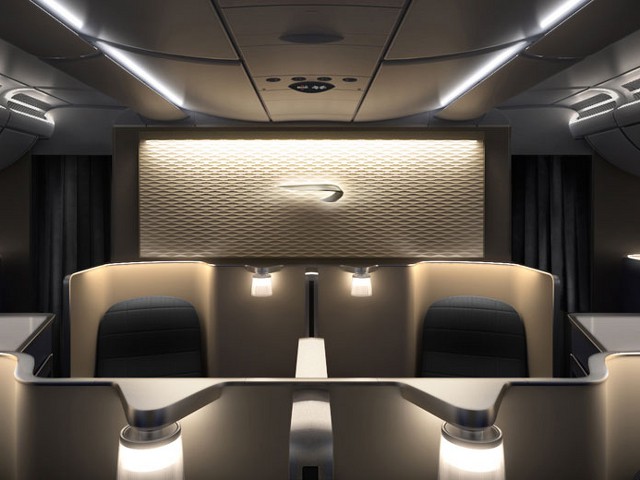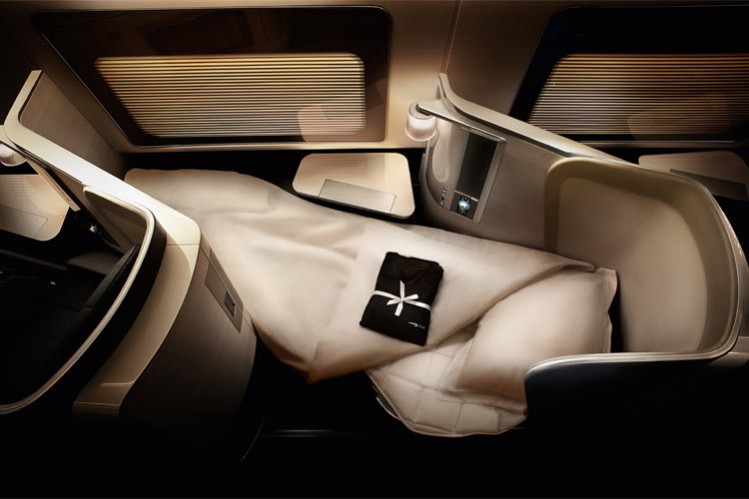Academy Director, Pauline Riley, recently attended the Hamburg Aircraft Interiors Expo where the purpose of the visit was to explore the diverse nature of this sector of the interiors industry. As a design education company, we have a great interest in many areas of our industry and always look to see how progressive design can be implemented in not just the residential sector, but that of commercial sectors.

The design of airline interiors is not a new subject area, however, over the last 5 years, this niche design area is becoming more prominent. With the launch of the Dreamliner and Airbus models, it is clear that the experience offered to those who travel on these types of aircraft is not solely directed by the latest offerings in technology and how much Veuve Clicquot can be quaffed by those in First Class; the interior surroundings are now as much a part of the flying experience than it ever has been.
Aircraft interior design and its development was first brought to my attention a few years ago when one of our previous students had written her dissertation (as part of her BA Hons degree) on the development of commercial airline cabin interiors. The dissertation tracked how these interiors are designed to create an enjoyable experience for the passengers and how the development of these ideas can take airline cabin interior design to another level. Whilst I was aware that the interior of these spaces were ‘designed’ to an extent, it made me realise the possibilities of a well-conceived and thorough design concept were not kept to terra firma; these concepts also existed 35,000 ft in the air. Since reading this dissertation three years ago, I have kept my eye on the evolution of aircraft interior design, both commercial and private, to see just what is possible within what could be considered, as a large aluminium (or lately, carbon fibre) tube.
Looking far into the future first, I thought it would be interesting to touch on how one of the pioneers of aircraft manufacture, Airbus, sees the development of not only aircraft design itself, but that of the interior.
The Airbus Concept Plane was launched in 2010 and demonstrates what air transport could look like in 2050. According to Airbus, we could see these developments being implemented as early as 2030 “if advances in existing technologies continue apace” (Airbus, 2010).
As Airbus states, this concept plane has not been designed with the intention to fly, but “is a representation of the main technological fields that are being explored to face future needs: a significant cut in fuel burn and emissions, less noise and greater comfort” (Airbus, 2010).
The concept for the interior of the Airbus Concept Plane is inspired by nature and will be customised to the needs of individual passengers, with the traditional cabin class system being removed in favour of social ‘zones’ which target individual needs; relaxation, play, and business.
The layout is not only important in itself, but that of the materials used to create these environments. The materials and fittings used within the interior have been designed to reflect the complexities of nature; products being able to self-clean and self-repair thanks to innovations in dirt-repellent coatings and self-healing covers.
However, the Airbus Concept Plane is exactly that; a concept. Whilst technology may not have advanced to the stage where this concept may be possible just yet, what we do see with regards to the design of aircraft interiors is something becoming ever more opulent and being tailored specifically to the needs of the customer.
The first example comes from British Airways. Their first Airbus A380 rolled out of the hangar in April 2013 and whilst we don’t see the extravagance of some private luxury jets, we do see a sleek First Class cabin with low level LED mood lighting, set against a backdrop of moulded wall panels. The attention to detail paid to the seating and ‘client compartments’ are also to the highest standard.
However, there is only so far that a commercial airline can go in terms of being extravagant and opulent with their interiors. Not only do they have brand standards to work towards, but dealing with a range of clientele on a day-to-day basis, the interior must cater and appeal to as many as possible.
It is only when we get into the realms of privately owned, luxury jets where we see the interior design taking more of a centre stage.
The recently sold Airbus A380, once privately owned by Saudi Arabian royal Prince Al-Waleed bin Talal was reported to have had $100-$150 million spent on the design of its interior. The aircraft and mega-yacht specialist, Edése Doret, was tasked with transforming the interior into and ‘airborne palace’. A 14-seat dining table was designed for the Prince and his guests, complete with chromed chairs and crystal chandelier. This may sound like quite an extravagance to be had, however, when compared to the addition of the world’s first lift system in a plane (so guests can be easily transported to one of the three floors) and a whirlpool with “a rapid drainage system that can empty the standing water in seconds to a tank in the cargo hold” (Curbed.com, 2013) a 14-seat dining table doesn’t sound too absurd.
Another design coming from the Edése Doret team is featured in this Boeing 787-9 Dreamliner, which functions as both a mobile office and high-end living space. When asked about the complexties of designing such a project, Doret had this to say:
“Designing for an aircraft is a lot different than designing for a home. Everything in the aircraft needs to account for egress, access to emergency exits, passage in the hallways, and the materials also need to correspond to standards of weight and flame retardancy” (Doret, 2012).
The complex FAA regulations and specifications have to be adhered to, which can prove challenging when you are designing to suit the lifestyles of foreign dignitaries, heads of state, Fortune 500 executives, and independently wealthy executives.
These images don’t necessarily show that most extravagant of designs that the aircraft interior design world has to offer, yet it does show the expectations from both the commercial and private aircraft sectors.
So from where we are now to how Airbus sees the evolution of this side of the design industry over the next fifteen to thirty-five years, there is still a long way to go in the evolution of aircraft interiors.
References
Airbus Futures (2010) Airbus Frame [Online Image]. Available from: [Accessed 14/04/14].
Airbus Futures (2010) Airbus Future Cabin [Online Image]. Available from: [Accessed 14/04/14].
Aubst (2013) BA First Class section [Online Image]. Available from: [Accessed 14/04/14].
British Airways (2013) BA First Class Seating [Online Image]. Available from: http://www.britishairways.com/assets/images/information/travel-classes/first/750×500-BAFirst_Suite3.jpg [Accessed 14/04/14].
Brother Bangan (2013) Airbus 360 bedroom [Online Image]. Available from: [Accessed 14/04/14].
Brother Bangan (2013) Airbus 360 living room [Online Image]. Available from: [Accessed 14/04/14].
Brother Bangan (2013) Airbus 360 stairs [Online Image]. Available from: [Accessed 14/04/14].
Edése Doret (2012) Boeing 787 bed [Online Image]. Available from: [Accessed 14/04/14].
New American Luxury (2012) Boeing 787 meeting room [Online Image]. Available from: [Accessed 14/04/14].
New American Luxury (2012) Boeing 787 office [Online Image]. Available from: [Accessed 14/04/14].
Smithsonian (2010) Airbus Concept Plane [Online Image]. Available from: http://blogs.smithsonianmag.com/design/files/2012/08/conceptplane_1.jpg [Accessed 14/04/14].
Smithsonian (2010) Airbus Concept Seating [Online Image]. Available from: http://blogs.smithsonianmag.com/design/files/2012/08/conceptplane_seats.jpg [Accessed 14/04/14].






